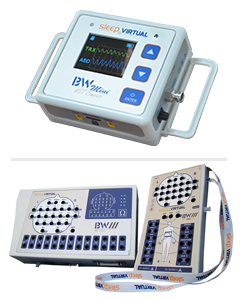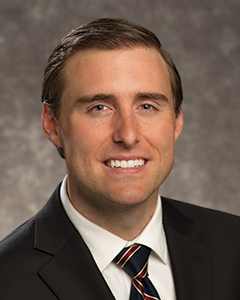 The small at-home device (top) slips on the chest band patients wear. They also wear a sensor on their finger and under their nose. The Sleep Center technology (bottom) provides more comprehensive testing, if needed. Illustration: Neurovirtual
The small at-home device (top) slips on the chest band patients wear. They also wear a sensor on their finger and under their nose. The Sleep Center technology (bottom) provides more comprehensive testing, if needed. Illustration: Neurovirtual
Responding to the increasing demand for sleep studies, NKCH recently replaced its at-home and Green Hills Diagnostic Sleep Center technology, doubling capacity for at-home sleep studies.
“With more home testing units, we can reduce our wait times for patients needing home sleep studies,” said Scott Shorten, MD, a neurologist and sleep medicine specialist with Meritas Health Neurology.
Home Study
In-home studies help determine if obstructive sleep apnea is the cause of daytime sleepiness or sleep disruptions. When untreated, obstructive sleep apnea brings greater risk of:
- Congestive heart failure, heart attack, hypertension and stroke
- Death in people who also have obstructive pulmonary disease
- Recurrence of atrial fibrillation in patients with an AFib diagnosis
- Development of anxiety and depression
Patients only need to wear a band around their chest and two sensors — one on their finger and one under their nose. After an overnight at home, they return the equipment to the sleep center, where registered polysomnographic technologists download the data to a new system that more easily integrates with the patient’s electronic medical record. Patients identified as having OSA may be treated with a continuous positive airway pressure machine or potentially other alternatives, depending on severity.
“Some people are afraid of an OSA diagnosis, but it’s very treatable, and getting good quality sleep can be a major life-changer,” said Dr. Shorten, who is board certified in neurology and sleep medicine.
Sleep Center Study
If a home sleep test does not show OSA, the patient may need more comprehensive testing at the sleep center, which is accredited by the American Academy of Sleep Medicine, for evaluation of other sleep disorders. Dr. Shorten is medical director of the sleep center.
Patients spend a normal sleep period (night or day) in a room that looks and feels like a bedroom with a full-size bed, private bathroom and television. Technologists, who are specially trained and experienced in conducting sleep studies tailored to specific needs, attach special electrodes to the patient’s head, chest and legs. Once asleep, the technologist monitors brainwave activity, eye activity, heart rate, airflow, chest and abdomen movement, and oxygen levels. Often, when OSA is diagnosed, the technologist will start CPAP and slowly escalate the settings until the sleep apnea is alleviated.
“A home study is specific to diagnosing OSA,” Dr. Shorten added. “It cannot detect periodic limb movement disorder or other sleep disorders,” Dr. Shorten said. “When other diagnoses are suspected or when there is concern for supplemental oxygen or potential seizures, a traditional in-facility sleep study is more appropriate.”
Sleep and Health
Dr. Shorten’s desire to care for people with sleep issues is rooted in his appreciation of the relationship between sleep and overall health.
“Helping patients carry out their lives in an alert manner so that they can accomplish their goals in life is very rewarding,” Dr. Shorten said. “Since I completed my fellowship six years ago, sleep medicine has continued to gain more recognition as an important foundation for general, physical and mental health.”

Scott Shorten, MD
Scott Shorten, MD earned his medical degree from the University of Kansas School of Medicine. After completing his internship in internal medicine and residency in neurology at KU Medical Center, he was a fellow in sleep medicine at Vanderbilt University.